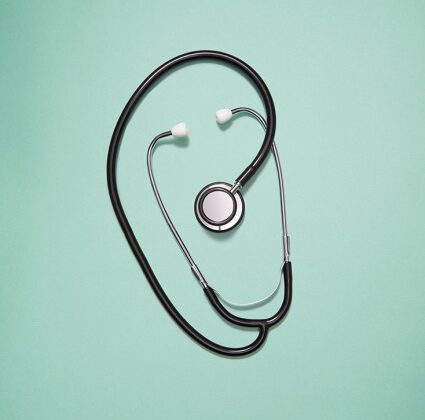
Sound environments – hospitals are noisy
Often very noisy. Hardly ever even close to the maximum limit of 35 dB set by the World Health Organization (WHO) that would be considered a healing sound environment. Both patients and staff can be adversely affected by this noisy sound environment.
The growing number of technological devices, an increasing flow, and turnover of patients and relocations within the hospital are a few reasons the noise level in hospitals has escalated. Patients in emergency rooms, intensive care units (ICU), operating theatres, and infants in neonatal units are particularly exposed to noise.
Scientific studies indicate that loud noise from equipment, alarms, and voices contribute to raising the patient’s level of stress and disrupting the healing sleep (1 )
How do these noisy sound environments affect medical and nursing staff? Staff devotes about 40 percent of their time to communicate in one way or another. In order to get better access, visibility of, and proximity to their patients, medical staff is often placed in an open landscape. Such as nursing stations located at the intersections of corridors, at emergency rooms, and ICUs.
In this area, they need to be able to perceive and interpret the alarm sounds, have confidential conversations, perform consulting work and in many cases work with complex medical data. A poor sound environment increases the risk of lapses in communication, thus increasing the risk of errors and contributing to an unnecessarily high level of stress on the staff.
Mimicking nature

However, we can counteract this. Our hearing is designed to work optimally outdoors, in nature. It is therefore important to try to emulate the sound environment of nature inside the hospital. In nature, we seldom find straight, parallel surfaces that reflect sound waves back and forth, creating disturbing reflections.
Irregular room designs can help with that! Perhaps the corridor can be built with smaller niches breaking the long sound propagation? Ward rooms may not need to be shaped as a rectangle. Reception and entrances can be divided into smaller separated areas using partitions, to create ‘rooms within the room’. Convex-shaped reception desks will help to diffuse (spread) the sound waves so that they are split up rather than bouncing back and forth. This way more sound energy will reach into sound absorbers in the ceilings and on the walls.
The same phenomenon occurs when using rounded corners and columns. To prevent the sound to spread in the room, we can use sound-absorbing wall panels. They will minimize the horizontal sound reflections and lowers the total noise level in the room. One idea might be to print a fitting motif on the wall panels, such as lovely tranquil nature images that help to create peace and security.
The ICU often struggles with high noise levels close to the patient´s ears. It is common to collect all infusion devices together for good ergonomics and efficiency, but most of them are also equipped with sound alarms. For some alarms, it is essential that the staff can detect them and react on them immediately, but other signals might not be as urgent.
My advice is to make well thought-through and strict demands on the equipment purchased.
Have a dialogue with the manufacturers; they are often not aware of the multitude of signals staff will have to relate to in their daily work. Could we change some alarms into flashing lights instead, or make the signal increase slowly in strength after a while but start of softly? There are many ideas and prototypes for other alarm functions that do not use audio signals. And if we continue to ask for them more ideas will inevitably lead to new solutions.
Sound environments – the brain is always on alert!
 It´s important to separate noisy activities from quiet activities already in the early planning stages, when building a hospital. With increased distance from the sound source, sound levels will be lowered. This can be applied at basic floor planning and placement of sluice rooms for example. To the daily care of the patient as by increasing the distance between the sound source and the patient’s ears. Should the alarm instead be heard only by the staff?
It´s important to separate noisy activities from quiet activities already in the early planning stages, when building a hospital. With increased distance from the sound source, sound levels will be lowered. This can be applied at basic floor planning and placement of sluice rooms for example. To the daily care of the patient as by increasing the distance between the sound source and the patient’s ears. Should the alarm instead be heard only by the staff?
Our hearing is never turned off and the brain processes all the sound waves even if a person is sedated or asleep.
Once we start thinking about noise at our workplaces we might discover that there is a lot we can do differently. How about the noise staff generate? Opening a sterile packaging can generate a noise of 70 dB! Maybe one should avoid doing this near the patient’s ears. Rather take a step closer to the footboard if possible?
Overhearing between patients is often experienced as unpleasant and is one of the worse memories some bring home from the ICU. Use sound absorbing screens between patients. Possibly with a glass section at the top, so that staff do not lose the overview to other patients.
The operating theater may also be a loud place, especially in orthopedic surgery where the surgeon uses drill and saw. It is crucial for the team to be able to hear one and other during a procedure. Speech clarity and supportive lip reading is affected by the fact that both ears and mouth are covered by sterile draping on some or all members of the operating team.
Operating rooms are often made from washable and hard materials on floors and walls. Ceilings are sometimes made of hard materials that contribute to high noise levels and long reverberation time. But this can all be aided by special absorbing ceilings and wall absorbers that meet hygiene and cleaning requirements (requirements can differ between countries). The sound environment does not have to be compromised!
Set the sound environments bar high
Summary advice:
- Good acoustic behavior is contagious.
- Try to separate quiet and noisy activities.
- Set noise requirements for all equipment and inventory that generate unnecessary noise – it can sometimes be food carts or automatic door openers.
- Make full use of sound absorbing materials.
We need hospitals with healing sound environments built for real people that feel, hear and sense their surrounding! For more tips continue reading here or here,
Ref:
- Hsu, Ryherd, Ackerman, Persson Waye, ‘Noise Pollution in Hospitals: Impacts and Patients’, J. Clin. Out. Mgmt. 2012, vol. 19

